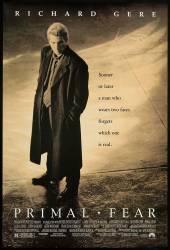Other mistake: When Aaron is asked how he pleads, Vail instructs him to not answer and invoke his Fifth Amendment right. He then presents the judge with case law that supports that instruction. Roy attacks Martin after the doctor has left the room. That means the evaluation is still being completed. But after the attack, Vail tells the doctor he cannot change the plea in the middle of a trial. There could not yet have been a plea because the evaluation was still being done.

Primal Fear (1996)
1 other mistake
Directed by: Gregory Hoblit
Starring: Richard Gere, Edward Norton, Laura Linney
Continuity mistake: In the scene in the bar when Martin is talking to the reporter and drinking, the napkin with the slice of lime on the counter in front of the liquor bottle moves from place to place in the shots, and to start with the reporter is on Martin's right (viewed from behind the bar) and then on his left (from the bar side).
Martin Vail: I also need case histories on murder by stabbing, murder by mutilation, murder by religion. Also, I'm gonna need a psychiatrist.
Naomi Chance: You're telling me.
Trivia: The part of Aaron Stampler was originally written for Leo Dicaprio. He turned the role down and it was given to Edward Norton.





Answer: Later in the film it's said B32 is a catalog code for the book "The Scarlet Letter", page 156. On that page was an underlined passage "No man, for any considerable period, can wear one face to himself and another to the multitude without finally getting bewildered as to which may be the true..."
Bishop73